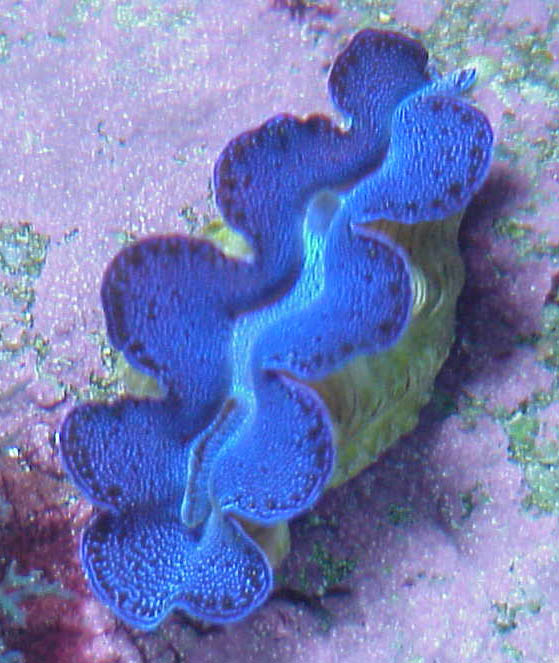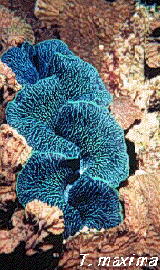
Giant Clams are one of the most sought after invertabres for the reef aquarium. Their pychedelic colors and neat structure makes them a remarkable addition. Add to this the fact that they rapidly take Nitrate out of the systems they inhabit, and one can see why people are so facinated with adding them to their reefs. These Clams are from the Cariacea family, from the Subfamily Tridacnidae, with Tridacna and Hippopus making up the two genre. The longest Giant Clam recorded is 4.5 feet, while the heaviest is 150 pounds. Most species come in a wide variety of colors.

Like corals, Giant Clams shelter Zooxanthellae in their tissues. This lets them take in light, unlike most Mollusks which are filter feeders. The density of Zooxanthellae in their tissues is far greater than that of corals, making them more efficient. They also have a stomach, two kidneys, an esophagus, gills, and other features that make them much more evolved than corals. The Zooxanthellae harboring system has been compared to a Circulatory system as well. The efficency of these creatures in obtaining energy from their Zooxanthellae is one reason why they are able to surpass so many other Mollusks size-wise. These Clams are pretty much non-aggressive. A temparture of 74-82 and a salinity of 1.022-1.025 is ideal. Calcium should be added, along with low levels of Iodide, and Strontium. High doses of Iodide will kill them, however, the typical reef-tank dose will be fine.
Purchase your Clams at a size between 3 inches and 9 inches ideally, although larger is better than smaller. Ones under 2 inches are much harder to keep alive. There are many places selling captive bred Giant Clams now, and they should obviously be a first choice, due to being more adaptive and hardier, and to conserve the reefs of course. Giant Clam meat is a delicacy in many countries, and it has lead to a shortage of wild clams. Try to make sure the Clam is responsive to light before purchase. Two places one can purchase captive raised Clams from are www.aquatic-specialists.com and www.inlandreef.com
Besides light, Giant Clams also take in phytoplankton, zooplankton, fish wastes, and other foods. In a well established system, feeding is not really needed.

Tridacna gigas is the largest Clam, reaching 3 feet, and T. deresa is second, coming in at 2 feet. These two Clams can easily attain a length of over 10 inches within 5 years in good conditions. These are quite hardy Clams, with the Deresa being slightly hardier and more adaptable than the Gigas. They like only soft-moderate currents, and water parameters should remain very stable for them. Coming from deeper waters, the Gigas needs the least amount of light of any of the Clams. Both of these ideally like to attach to sand.
T. crocea is an incredibly pretty Clam. The maxiumn length is usually recorded around 6 inches. It is a shallow water invertabre, and therefore needs the most light of any of the Giant Clams. It also likes a moderate amount of water movement around it, and is quite adaptable. It likes to be placed on rocks as opposed to sand, and should be placed high up in the aquarium where it will recieve more light. It is known to sometimes burry itself almost entirely into rock crevices. They need to have strong Metal Halodie lighting to survive.
T. squamosa comes from deeper water. Most adults like to rest on sand. They grow up to 16 inches. This Clam does not require Metal Halodie lighting to thrive, and can be kept under 6 flourescents with little diffuculty if placed high up in the tank.
T. maxima needs to be kept under Metal Halodie lighting. It is more of a shallow water species that is pretty easy to keep overall. It likes to be placed on rocks. It grows up to 14 inches.
Hippopus hippopus grows to 16 inches and is quite hardy.
Good quality Metal Haloide lights are one of the preresqequites to keeping most Clams. Nitrates under 10 ppm, and very stable salinity levels and other parameters are also essential. These animals do very well in captivity if given their needs, like most invertabres. The addition of a Giant T. Clam to a tank is one of the best things you can do, and is always a topic of conversation. These animals are very expensive, you may well pay 200$ for a small one, but shop around online, and look into getting captive bred Clams and you can find them for much much lower. They are well worth it :-) Be sure to check out any of Daniel Knopís publications for more info, and I can be reached as well at witmer26@erols.com, or on our discussion forum at this website.
Click here to Go Back to the Main Page